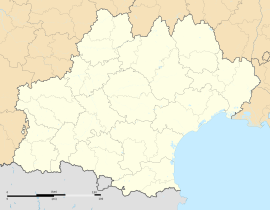You can help expand this article with text translated from the corresponding article in French. (December 2008) Click [show] for important translation instructions.
|
Limoux (French pronunciation: [limu] ; Occitan: Limós [liˈmus]) is a commune and subprefecture in the Aude department, a part of the ancient Languedoc province and the present-day Occitanie region in southern France. Its vineyards are famous for being first to produce sparkling wine known as Blanquette de Limoux.
Limoux | |
|---|---|
Subprefecture and commune | |
 Saint-Martin church and the Pont-neuf in Limoux | |
| Coordinates: 43°03′28″N 2°13′09″E / 43.0578°N 2.2192°E | |
| Country | France |
| Region | Occitania |
| Department | Aude |
| Arrondissement | Limoux |
| Canton | La Région Limouxine |
| Government | |
| • Mayor (2020–2026) | Pierre Durand[1] (PS) |
| Area 1 | 32.41 km2 (12.51 sq mi) |
| Population (2021)[2] | 10,302 |
| • Density | 320/km2 (820/sq mi) |
| Time zone | UTC+01:00 (CET) |
| • Summer (DST) | UTC+02:00 (CEST) |
| INSEE/Postal code | 11206 /11300 |
| Elevation | 156–740 m (512–2,428 ft) (avg. 172 m or 564 ft) |
| 1 French Land Register data, which excludes lakes, ponds, glaciers > 1 km2 (0.386 sq mi or 247 acres) and river estuaries. | |
Geography
editLimoux lies on the river Aude about 30 km (19 mi) due south of Carcassonne. In February 1965, it absorbed the former commune Vendémies.[3] Limoux has two railway stations on the line to Carcassonne: Limoux station and Limoux-Flassian station.
Population
edit
|
| ||||||||||||||||||||||||||||||||||||||||||||||||||||||||||||||||||||||||||||||||||||||||||||||||||||||||||||||||||
| |||||||||||||||||||||||||||||||||||||||||||||||||||||||||||||||||||||||||||||||||||||||||||||||||||||||||||||||||||
| Source: EHESS[4] and INSEE (1968-2017)[5] | |||||||||||||||||||||||||||||||||||||||||||||||||||||||||||||||||||||||||||||||||||||||||||||||||||||||||||||||||||
Blanquette de Limoux
editBlanquette de Limoux is produced around the city of Limoux. The main grape of the wine is Mauzac, followed by Chardonnay and Chenin blanc. Wine historians believe that the world's first sparkling wine was produced in this region in 1531, by the monks at the abbey in Saint-Hilaire, Aude.
Culture
editThe town is perhaps best known for its Winter festival called Fecos [ˈfekɔs], often referred to (inaccurately) as a Carnival or Fête. It is generally referred to as Carnival de Limoux in French language. It is known for its British expatriate population.[6]
During the French Revolution, demonstrators forced officials to seal the granaries, demanded an end to dues and indirect taxes and then ransacked the tax-collector's offices and threw records into the River Aude.[7]
Images
edit-
Town square
-
Carnival
Sights
editThe heart of the town is the place de la République, a wide square with some fine stone arcading and a number of timber-framed houses. Limoux straddles the River Aude and the banks are lined with grand houses, especially on the eastern side, the so-called Petite Ville (lit. "Small City").
While worth visiting in itself, the town is also a good base for discovering the history of the region and is ideally placed for exploring the coast, the mountains and some good walking country.
Markets
edit- Weekly market every Friday (or Thursday if a public holiday falls on a Friday).
- Flea market or Brocante the first Sunday of each month on the Promenade du Tivoli.
- Evening markets on Tuesdays in July and August.
Other sights
edit- The Musée Petiet (Tourist Information Office),
- Musée du Piano (Museum of the piano)
- CathaRama (a history of the Cathar movement).
- Winery tours at Sieur d'Arques and Aimery.
- Jardin aux Plantes la Bouichère - Flassian, 2 hectares of gardens which is home to various collections of increasingly rare plant varieties. Currently closed, updated May 2024.
Personalities
editLimoux was the birthplace of:
- Francis de Gaston, Chevalier de Levis (1719–1787), Marshal of France
- Alexandre Guiraud (1788–1847), poet, dramatic author and novelist
See also
edit- Corbières Massif
- Limoux Grizzlies, a rugby league club from Limoux
- Limoux wine, white wine, usually sparkling, produced in the area
- Communes of the Aude department
References
edit- ^ "Répertoire national des élus: les maires" (in French). data.gouv.fr, Plateforme ouverte des données publiques françaises. 6 June 2023.
- ^ "Populations légales 2021" (in French). The National Institute of Statistics and Economic Studies. 28 December 2023.
- ^ Modifications aux circonscriptions territoriales de communes, Journal officiel de la République française n° 0044, 21 February 1965, pp. 1483-1485.
- ^ Des villages de Cassini aux communes d'aujourd'hui: Commune data sheet Limoux, EHESS (in French).
- ^ Population en historique depuis 1968, INSEE
- ^ Astier, Henri (29 November 2018). "The French village that fears for its Brits". BBC News.
- ^ Mcphee, Peter. Liberty or Death.



